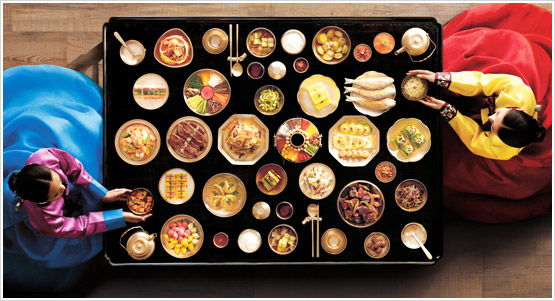Korean Traditional Festivals are the Korean national and local festivals that have been continued among Korean people throughout its long history. Korean traditional festivals are largely based on its agricultural rituals and myths. "Seollal, New Year's Day" and "Chuseok, Harvest Festival" are regarded as the biggest festivals. As a general note, most celebrations happen in the spring or autumn.
The Lotus Lantern Assembly,a traditional Korean folk festival that began centuries ago during the Goryeo Period. When Buddhism reached its zenith as ancient Korea’s state religion. But even today, the Seoul Lotus Lantern Festival continues the tradition of making and hanging lanterns as symbolic offerings of light, wisdom and compassion in a world too often filled with darkness and suffering.
SEOLLAL (1st month)
One of the biggest holidays in Korea along with Chuseok (also known as the Korean Thanks giving day). Seollal is the New Year’s Day in lunar calendar. On Seollal, Koreans demonstrate their respect to parents and elders in the family, as well as deceased ancestors through Sebae (New Year’s Bow) and Charye (an ancestral ritual). Also, elders give money or present to a person who did Sebae in return of showing their respect. Koreans always wear Hanbok (traditional clothing) on this day and eat Tteokguk (traditional soup made of rice cake).
DAEBOREUM (15th day of 1st month)
A day to celebrating the first full moon of the new year. Traditionally, group of people plays a traditional game called Geuybulnori a night before or on the day of Daeboreum. Farmers burn hays of dry grass on ridges between the rice fields while other people whirl around few cans with a lot of holes which allowed charcoals to fire inside the cans.
MEOSEUMNAL (2nd month)
A traditional festival for servants. This was a day that masters allowed their servants and slaves to celebrate a day with extra food, singing, and dancing before farming started in February. The masters also provided enough money for the servants so that the servants does not need to spend their money in the day. The servants usually made traditional snack called Songpyeon (a variation of Tteok (traditional rice cake) with the grains used during Daeboreum ate them according to their age, because they believed that this could bring them a good luck. Unfortunately, this festival is not celebrated any more since the Meoseum system was abolished in Korea, and it is even rare to see a person who remembers this festival.
YONGDEUNGJE (2nd month)
A day to celebrate the god of wind which is believed to descend on earth on the first day of February and ascend on the 20th. The festival is mostly celebrated in Jeju Island and Youngnam district. While Yongdeung is on earth, it is believed to bring strong wind. Thus, people in the sectors strongly affected by wind such as fishery and farming perform an ancestral ritual, in order to appease the wind god. If it rains or is cloudy on that day Yongdeung ascend, people think the year will be a fruitful one.
SAMJINNAL (3rd day of 3rd month)
A day of celebrating the coming of spring. Thus Samjinnal,the date with two 3s is considered as a lucky day with full of good and evil spirit. This is the day when the barn swallows return, snakes awaken from the winter sleep, and butterflies begin to fly. It is thought as good luck if one sees a snake on this day. Archery, flower viewing, and fortune telling are also enjoyed by the people celebrating this day. People would eat rice pancakes with flower topping known as Hwajeon (sweet pancake) and noodles, drinking Dugyeonju (Azalea wine).
One of the biggest four traditional festivals along with Seollal, Dano, and Cheseok, Hansik notifies the start of the farming season. During the festival, Koreans visit their ancestral graves for offering rite and cleaning and maintenance. Jesa, a traditional ritual is performed with the expectation of a fruitful year at the grave. Traditional food is prepared for the Jesa and shared with families and neighbors after the ritual has been performed. It is known that on Hansik, people should eat only cold food but people easily ignore it these days. Ssuktteok (a variation of Tteok), Ssukdanja (mugwort dumplings), and Ssuktang (mugwort soup) are the representative food for Hansik.
DANO (5th day of 5th month)
Traditional festival in celebration of spring and farming. On this day, women wash their hairs in water boiled with sweet flag (known as Changpo in Korea) and men wear iris roots around their waist to ward evil spirits. Main activities include folk games such as Ssireum (Korean wrestling match) and swing. Also, as it is a time when the summer comes, people present a fan to friends or neighbors wishing that they can beat the heat that summer. On Dano, people eat traditional foods including a variety of Tteok and other herb rice cakes.
CHUSEOK (15th day of 8th month)
Known as Hangawi, the Korean thanks giving Chuseok is one of the greatest traditional festivals. Takes place on the 15th day of the 8th lunar month under a full moon, people enjoy traditional games such as dancing, tug-of-war, and Ssireum (Korean wrestling match). People also perform traditional rituals such as Charye in respect and remembrance of their ancestors. As part of the ritual, people take care of the ancestral grave sites by mowing the grass and cutting off the weeds. People enjoy a variety of traditional foods and dishes like Songpyeon (Traditional rice cake made with the grains), Torantang (Taro soup) and liquor made of newly harvested fruits and vegetables. It is one of the most richest and festive festivals of the year.
REFERENCE KOREA FESTIVAL










No comments:
Post a Comment